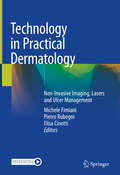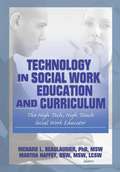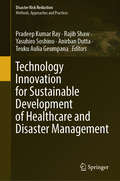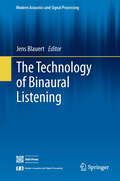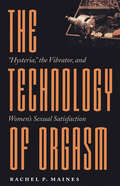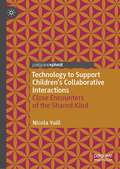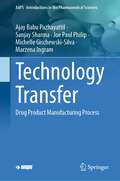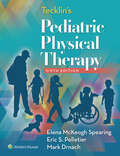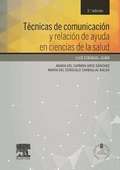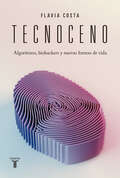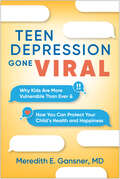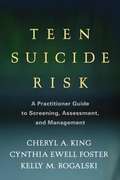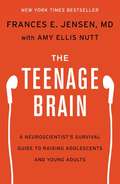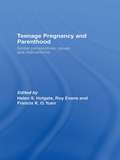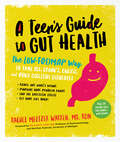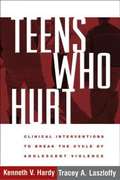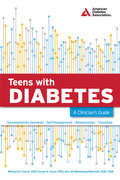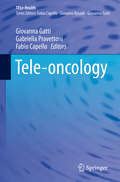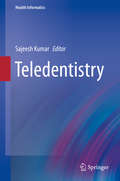- Table View
- List View
Technology in Practical Dermatology: Non-Invasive Imaging, Lasers and Ulcer Management
by Michele Fimiani Pietro Rubegni Elisa CinottiThis book provides a complete overview on the latest available technologies in dermatology, while discussing future trends of this ever-growing field. This handy guide provides clinicians and researchers with a clear understanding of the advantages and challenges of laser and imaging technologies in skin medicine today. It also includes a section on imaging techniques for the evaluation of skin tumors, with chapters devoted to dermoscopy, in vivo and ex vivo reflectance confocal microscopy, high frequency ultrasound, optical coherence tomography, and a closing part on latest approaches to wound management.Completed by over 200 clinical images, Current Technology in Practical Dermatology: Non-Invasive Imaging, Lasers and Ulcer Management is both a valuable tool for the inpatient dermatologist and for physicians, residents, and medical students in the field.
Technology in Social Work Education and Curriculum: The High Tech, High Touch Social Work Educator
by Florence W Vigilante Richard L Beaulaurier Martha F HaffeySave time and trouble as you incorporate technology into your social work curriculumThe dramatic increase in the use of computers and other forms of technology in social work education and practice has educators, trainers, and administrators investing valuable time, money, and effort into trying to make the transition from traditional teaching to a Web-assisted learning environment. Technology in Social Work Education and Curriculum takes the mystery out of the online experience with practical information on using technology to enhance and enrich learning-but not at the expense of the "human" approach to social work. This unique book presents a variety of creative and interesting methods for incorporating technology that&’s affordable and user-friendly, and for developing online skills that won&’t become obsolete as computer hardware and software evolves.Technology in Social Work Education and Curriculum transforms technology into an everyday resource for agency field instructors, human service educators, trainers, and social work administrators. The book addresses concerns that educators with limited technical skills may have in using technology to teach cultural competency, group work, research, direct practice, social policy and advocacy, and field practicum, presenting hands-on approaches that are innovative but accessible. And by focusing on approaches rather than simply reviewing available hardware and software, the book provides you with background knowledge that makes it easier for you to successfully incorporate online learning into the classroom. Technology in Social Work Education and Curriculum examines using instructional technology to emotionally engage students in the learning process using digital video and qualitative data analysis software to teach group practice the role technology plays in advocacy distance-education technologies in policy education incorporating Web-assisted learning into a traditional classroom setting the advantages of distance education over more conventional approaches a model for planning the use and integration of computer technology in schools of social work how the behaviors of computer consultants can affect the students who seek their help using innovation diffusion theory in technology planning and much more!Social workers have traditionally embraced the latest technologies and scientific developments since the earliest days of the profession. Technology in Social Work Education and Curriculum helps continue that tradition, offering invaluable guidance to educators and administrators, no matter how experienced-or inexperienced-they are in dealing with communications technologies.
Technology in the Hospital: Transforming Patient Care in the Early Twentieth Century
by Joel HowellPhysicians, Patients, and Medical Technology, Science, Scientific Systems, and Surgery, The Changing meaning of Urinalysis, Clinical use of the X-Ray Machine, The X-Ray Image, Blood and Blood Counts, Blood and Diseases, Machines and Medicine.
Technology Innovation for Sustainable Development of Healthcare and Disaster Management (Disaster Risk Reduction)
by Pradeep Kumar Ray Rajib Shaw Yasuhiro Soshino Anirban Dutta Teuku Aulia GeumpanaThis book provides holistic case studies of technology development, examples of its complexities and an in-depth analysis from the perspective of information infrastructure. Natural disasters such as cyclones, tsunamis, earthquakes and volcanoes have disrupted the lives of people all over the world, particularly in Asia. In order to manage disasters and mitigate the damage, many technologies—surveillance systems, for instance—have been developed. An example of natural disaster is the ongoing devastation caused by COVID-19, which highlights the multi-disciplinary nature of disaster management, including agriculture, healthcare, economics, environment, engineering and technology. The pandemic has also led to the development and uptake of technologies such as vaccine development, new biotechnological innovations, telemedicine, the Internet of things (IoT) and mobile health (mHealth) all over the world. The United Nations Sustainable Development Goals (SDGs) programme suggests an integrated approach to their development. For example, healthcare needs to be addressed in holistic perspectives including education, environment, economy and regulations, among others. These goals create challenges in the development, validation and deployment of new technology, with this book presenting a discussion of innovations in sustainable development of healthcare in the multi-disciplinary context of SDGs.
The Technology of Binaural Listening
by Jens BlauertThis book reports on the application of advanced models of the human binaural hearing system in modern technology, among others, in the following areas: binaural analysis of aural scenes, binaural de-reverberation, binaural quality assessment of audio channels, loudspeakers and performance spaces, binaural perceptual coding, binaural processing in hearing aids and cochlea implants, binaural systems in robots, binaural/tactile human-machine interfaces, speech-intelligibility prediction in rooms and/or multi-speaker scenarios. An introduction to binaural modeling and an outlook to the future are provided. Further, the book features a MATLAB toolbox to enable readers to construct their own dedicated binaural models on demand.
The Technology of Orgasm: "Hysteria," the Vibrator, and Women's Sexual Satisfaction (Johns Hopkins Studies in the History of Technology #24)
by Rachel P. MainesWinner of the Herbert Feis Prize from the American Historical Association Winner of the AFGAGMAS Biennial Book AwardWinner of the Science Award from the American Foundation for Gender and Genital Medicine From the time of Hippocrates until the 1920s, massaging female patients to orgasm was a staple of medical practice among Western physicians in the treatment of "hysteria," an ailment once considered both common and chronic in women. Doctors loathed this time-consuming procedure and for centuries relied on midwives. Later, they substituted the efficiency of mechanical devices, including the electric vibrator, invented in the 1880s. In The Technology of Orgasm, Rachel Maines offers readers a stimulating, surprising, and often humorous account of hysteria and its treatment throughout the ages, focusing on the development, use, and fall into disrepute of the vibrator as a legitimate medical device.
Technology to Support Children's Collaborative Interactions: Close Encounters of the Shared Kind
by Nicola YuillThis book explores how technology can foster interaction between children and their peers, teachers and other adults. It presents the Co-EnACT framework to explain how technology can support children to collaborate, so helping them to learn and engage enjoyably with the world, in both work and play. The focus is on children, rather than young people, but the principles of supporting interaction apply throughout all life stages. Chapters on classrooms and on autism explain principles behind using technology in ways that support, rather than obstruct, social interaction in diverse populations. Collaborative interaction involves both verbal and non-verbal behaviour and this book presents evidence from closely analysing children’s behaviour in natural settings. Examples from cutting-edge technology illustrate principles applicable to more widely-available technology. The book will be of interest to psychologists, educators, researchers in Human–Computer Interaction (HCI), particularly those designing with children in mind, and practitioners working with children who want to deepen their understanding of using technology for collaboration.
Technology Transfer: Drug Product Manufacturing Process (AAPS Introductions in the Pharmaceutical Sciences #10)
by Ajay Babu Pazhayattil Sanjay Sharma Joe Paul Philip Michelle Gischewski-Silva Marzena IngramCurrently, there are no textbooks on drug product manufacturing technology transfer that incorporate the latest regulatory expectations. Recent guidance from regulatory bodies such as the US FDA, EMEA, WHO, and PIC/S has adopted the ICH Lifecycle approach harmonizing concepts across regulatory guidance. This allows organizations to align their technology transfer activities for all regulated markets. However, there is a need for consensus and direction in approaching technology transfer, particularly in understanding how to manage the scale-up effects to ensure regulatory compliance.This textbook offers technology transfer solutions and guidance to the pharmaceutical industry. The chapters provide a systematic understanding of applying the technology transfer concepts in pharmaceutical manufacturing, promoting standardization within the industry. Since Stage 1b is not specified in detail within the regulations, pharmaceutical organizations are left to determine the requirements of the stage. The need to justify the methodologies and utilization of sound science makes it more demanding. The textbook’s authors provide innovative solutions for technology transfer challenges, making it a comprehensive reference document. The approaches can be applied to both small-molecule and large-molecule drug product manufacturing segments, addressing the unmet needs of the industry.
Technosleep: Frontiers, Fictions, Futures
by Catherine Coveney Michael Greaney Eric L. Hsu Robert Meadows Simon J. WilliamsThis book draws on a variety of substantive examples from science, technology, medicine, literature, and popular culture to highlight how a new technoscientifically mediated and modified phase and form of technosleep is now in the making – in the global north at least; and to discuss the consequences for our relationships to sleep, the values we accord sleep and the very nature and normativities of sleep itself.The authors discuss how technosleep, at its simplest denotes the ‘coming together’ or ‘entanglements’ of sleep and technology and sensitizes us to various shifts in sleep–technology relations through culture, time and place. In doing so, it pays close attention to the salience and significance of these trends and transformations to date in everyday/night life, their implications for sleep inequalities and the related issues of sleep and social justice they suggest.
Tecklin's Pediatric Physical Therapy
by Elena McKeough Spearing Eric S. Pelletier Mark DrnachTrusted for decades by Physical Therapy students as well as experienced therapists who want to improve their knowledge, Tecklin’s Pediatric Physical Therapy provides a comprehensive and logical overview of some of the most common pediatric physical therapy diagnoses. This straightforward approach presents basic medical information regarding common clinical diagnostic categories followed by coverage of physical therapy examination, intervention and special considerations within each diagnostic group. Content in this 6th Edition has been thoroughly updated and reorganized to help prepare students for today’s clinical challenges, accompanied by case studies and interactive features that reinforce understanding and instill the clinical decision-making skills essential to successful practice.
Técnicas de comunicación y relación de ayuda en ciencias de la salud (Spanish Edition)
by Luis Cibanal Juan María del Carmen Arce Sánchez María del Consuelo Carballal BalsaNueva edición de la obra Técnicas de comunicación y relación de ayuda en ciencias de la salud que pretende seguir siendo un referente dentro de las técnicas de comunicación dirigida a profesionales sanitarios, principalmente médicos y enfermeras. <P><P>Se incluyen temas nuevos como la relación de ayuda en duelos, técnicas de comunicación y relación con personas violentas, cómo comunicar un diagnóstico grave o la muerte, etc. <P><P>En esta nueva edición se incluye una batería de vídeos en la página web para poder explicar con detalle todas las técnicas descritas en la obra. <P><P>Sin duda, la obra en español sobre técnicas de comunicación de referencia para profesionales sanitarios, principalmente médicos y enfermeras. <P><P>Trata todos los aspectos fundamentales para mejorar la comunicación entre los profesionales sanitarios y los pacientes, fundamental para garantizar una atención sanitaria óptima. <P><P>La obra incorpora temas nuevos como la relación de ayuda en duelos, técnicas de comunicación y relación con personas violentas, cómo comunicar un diagnóstico grave o la muerte, etc.
Tecnoceno: Algoritmos, biohackers y nuevas formas de vida
by Flavia CostaDescripción de esta era en la que, mediante la puesta en marcha de tecnologías de alta complejidad y altísimo riesgo, dejamos huellas en el mundo que exponen no solo a las poblaciones de hoy, sino a las generaciones futuras, de nuestra especie y de otras especies, en los próximos milenios. Chernóbil, la crisis financiera de 2008, los incendios en el Amazonas o la pandemia de coronavirus no son eventos aislados. Son "accidentes normales", síntomas del crecimiento y la destrucción acelerados, que, en menos de setenta años, transformaron nuestra vida y la del planeta para siempre. En Tecnoceno Flavia Costa delinea con sutileza la trama cultural y política de este mundoambiente alucinatorio cuya virtualidad se sostiene en una red material hecha de cables, satélites y edificios, por donde desfilan bioartistas, ciencia forense, organizaciones de derechos humanos, sistemas de vigilancia y empresarios transhumanistas. Y advierte sobre el papel clave que cumplen hoy las huellas: las biométricas, las comportamentales y las que dejamos en el suelo, la atmósfera y los océanos. Unas porque su capitalización ha desatado una feroz batalla geopolítica. Otras porque de ellas depende el futuro de la Tierra. «Los "accidentes normales" no son producto de una guerra, una negligencia o un sabotaje, sino que son inseparables de la productividad del sistema, de su desarrollo, de su incremento y de las contingencias que siempre se abren cuando se dispara una acción tecnológica hipercompleja hacia el futuro.» «Estamos ante una nueva cultura del yo que se exhibe ante los demás; un sujeto que, así como asume la individualidad somática, se reconoce también como emisor continuo de señales, como obra viviente, que se experimenta, se expresa, se juzga y actúa sobre sí, en parte, en el lenguaje del espectáculo. Y que se entrena como creador de su propia audiencia.»
Tecnologías que enferman: Efectos nocivos de la contaminación electromagnética y cómo protegerse
by Juan Adrián Karca Rafael Hernandez MoscosoAprenda a cómo protegerse de la contaminación electromagnética. Los aparatos electrónicos se están tomando nuestra vida: vivimos conectados a un celular, un computador, un televisor, una tableta. Hay muchas ventajas del desarrollo pero también hay un lado más sombrío del que pocos hablan: la tecnología moderna tiene efectos negativos en nuestra salud debido a la contaminación eléctrica y magnética que produce. Cada vez la evidencia es más contundente sobre los impactos que tiene en el sistema inmune, el sistema neurológico y la salud mental, entre otros. El propósito de este libro es que cualquiera que lo lea pueda conocer y tomar conciencia de la contaminación invisible proveniente dela tecnología que lo rodea. Este libro revela los avances científicos que se han hecho para determinar los efectos nocivos de estas radiaciones, muestra formas prácticas para protegerse de la contaminación electromagnética y contiene una guía para que el lector determine si es una posible víctima de estas energías.
Teen Depression Gone Viral: Why Kids Are More Vulnerable Than Ever and How You Can Protect Your Child's Health and Happiness
by Meredith E. GansnerWhat are the warning signs of depression in teens? When do social media and gaming habits cross the line into putting kids at risk? How can parents keep teens healthy and safe--without sledgehammering all their devices? This realistic, nonjudgmental guide from adolescent psychiatrist and parent Meredith E. Gansner provides the latest information about depression in teens, with a special focus on digital media use. Filled with vivid stories, the book helps you understand teen mental health problems and self-harm; find an accurate diagnosis; work with your child to develop healthier habits, aided by downloadable practical tools; and make informed treatment decisions. Dr. Gansner explores myths and facts about internet addiction, dangerous viral trends, and cyberbullying, and describes actionable steps for curbing them. Every chapter also identifies positive technology resources for both kids and parents, from supportive online communities to health-promoting sites and apps.
Teen Suicide Risk
by Cynthia Ewell Foster Kelly M. Rogalski Cheryl A. KingMeeting a vital need, this book helps clinicians rapidly identify risks for suicidal behavior and manage an at-risk teen's ongoing care. It provides clear guidelines for conducting suicide risk screenings and comprehensive risk assessments and implementing immediate safety-focused interventions, as well as longer-term treatment plans. Designed for day-to-day use in private practice, schools, or other settings, the volume is grounded in a strong evidence base. It features quick-reference clinical pointers, sample dialogues with teens and parents, and reproducible assessment and documentation tools. Purchasers get access to a Web page featuring most of the reproducible materials, ready to download and print in a convenient 8 1/2" x 11" size.
The Teenage Brain: A Neuroscientist's Survival Guide To Raising Adolescents And Young Adults
by Frances E. Jensen Amy Ellis NuttNew York Times Bestseller<P><P> Drawing on her research knowledge and clinical experience, internationally respected neurologist—and mother of two boys—Frances E. Jensen, M.D., offers a revolutionary look at the science of the adolescent brain, providing remarkable insights that translate into practical advice for both parents and teenagers.<P> Driven by the assumption that brain growth was pretty much complete by the time a child began kindergarten, scientists believed for years that the adolescent brain was essentially an adult one—only with fewer miles on it. Over the last decade, however, the scientific community has learned that the teen years encompass vitally important stages of brain development.<P> Motivated by her personal experience of parenting two teenage boys, renowned neurologist Dr. Frances E. Jensen gathers what we’ve discovered about adolescent brain functioning, wiring, and capacity and, in this groundbreaking, accessible book, explains how these eye-opening findings not only dispel commonly held myths about the teenage years, but also yield practical suggestions that will help adults and teenagers negotiate the mysterious world of adolescent neurobiology.<P> Interweaving clear summary and analysis of research data with anecdotes drawn from her years as a parent, clinician, and public speaker, Dr. Jensen explores adolescent brain functioning and development in the contexts of learning and multitasking, stress and memory, sleep, addiction, and decision-making.<P> Rigorous yet accessible, warm yet direct, The Teenage Brain sheds new light on the brains—and behaviors—of adolescents and young adults, and analyzes this knowledge to share specific ways in which parents, educators, and even the legal system can help them navigate their way more smoothly into adulthood.
Teenage Pregnancy and Parenthood: Global Perspectives, Issues and Interventions
by Helen S. Holgate Roy Evans Francis K. O. YuenThe debate of teenage pregnancy and parenthood continues to be a topical media and political issue, and a contested policy area. Covering the controversial issues, this book contributes to the debate, filling the gap in the current market. The strong chapter selection looks at areas such as: education social policy and welfare reforms in the UK and US issues for young fathers child sex abuse girls with emotional and behavioural difficulties. This is invaluable reading for those working on government strategies to reduce teen pregnancies and those working in sex education and youth care.
Teenagers' Citizenship: Experiences and Education (Relationships and Resources)
by Susie WellerThe introduction of compulsory citizenship education into the national curriculum has generated a plethora of new interests in the politics of childhood and youth. Citizenship for Teenagers explores teenagers’ acts of and engagement with citizenship in their local communities and examines the role of citizenship education in creating future responsible citizens. The first half of the book provides the context for teenagers’ experiences of citizenship, discussing issues around the ideas of childhood and citizenship, as well as the curriculum. The second half goes on to explore teenagers’ experiences of citizenship education, practising citizenship and exclusion from citizenship. The book concludes with a call for a new cumulative approach to citizenship which upgrades the status of teenagers, particularly within the classroom. Susie Weller’s important book will throw new light on how teenagers engage with citizenship education and take on civic responsibility. It is an interesting and useful read for all those involved with education and youth policy as well as those studying for a PGCE or researching in citizenship education.
The Teen's Guide to Gut Health: The Low-fodmap Way To Tame Ibs, Crohn's, Colitis, And Other Digestive Disorders
by Rachel Meltzer WarrenTake charge of your gut health now with the low-FODMAP diet. Are you a teen dealing with stomach problems? If so, you’re not alone! Fourteen percent of high school students have symptoms of IBS—such as pain, bloating, and frequent trips to the bathroom. Plus (as if that weren’t bad enough!), poor gut health can mean missed school days and trips, awkward explanations, extra doctor’s visits, and major cafeteria confusion. Here’s the good news: In A Teen’s Guide to Gut Health, registered dietitian Rachel Meltzer Warren explains how you can find relief—on a low-FODMAP diet. GET DIAGNOSED: Whether it’s IBS, Crohn’s disease, colitis, or something else, Rachel Meltzer Warren explains the differences and who can help. GET FODMAP SAVVY: “FODMAPs” are certain carbs that can be hard to digest, and they lurk in many kinds of goodfor-you food, from apples to yogurt. Identify your triggers and learn to avoid them—with a twopart elimination diet, shopping lists, meal plans, and more. GET YOUR QUESTIONS ANSWERED: No topic is too embarrassing for Meltzer Warren. You’ll also find “Real Talk” from real teens throughout! GET COOKING! Plus, 30 simple, gluten-free recipes that are low-FODMAP-approved and great for meals, snacks, and sharing.
Teens, Screens, and Social Connection: An Evidence-Based Guide to Key Problems and Solutions
by Alma Spaniardi Janki Modi AvariThis book explores the increasingly important intersection of the digital world and mental health in the lives of pediatric and young adult populations. Young people are spending a considerable amount of time on digital screen activities such as social media, texting, and online gaming. The vast majority of teens and pre-teens have access to computers and smartphones shifting social interaction away from face-to-face contact toward online communication. A practical resource, Teens, Screens, and Social Connection provides the reader with a targeted yet comprehensive understanding of a wide variety of internet and media-related topics facing youth today. Chapters include discussions on the developmental view from early childhood to young adulthood as well as the unique racial and cultural issues pertaining to technology and media. The book provides both the challenges of the internet and media to be identified as well as solutions and clinical pearls that can be immediately applied to clinical practice and real-world scenarios. This book is a practical reference that functions as a concise yet comprehensive summary of the most important aspects of this very timely and important topic. It is an invaluable, practical resource for mental health clinicians, as well as students and those professionals who work with youth in other domains.
Teens Who Hurt
by Tracey A. Laszloffy Kenneth V. HardyOffering a fresh perspective on treatment, this book presents an overarching framework and many specific strategies for working with violent youth and their families. The authors shed light on the complex interplay of individual, family, community, and societal forces that lead some adolescents to hurt others or themselves. Effective ways to address each of these factors in clinical and school settings are discussed and illustrated with evocative case material. The book provides essential guidance on connecting with aggressive teens and their parents and managing difficult situations that are likely to arise. The strengths-based interventions presented are applicable to a broad range of high-risk behaviors, from bullying and assault to substance abuse, self-mutilation, and suicidality.
Teens with Diabetes
by Michael A. Harris Korey K. Hood Jill Weissberg-BenchellWritten by three psychologists with more than 50 years of collective experience in the field of diabetes and youth, Teens with Diabetes provides evidence-based techniques for clinicians to treat the psychological needs of children with diabetes and help them transition into their teenage years. The authors have provided care to thousands of diabetic teens and their families from initial diagnosis to leaving home for college. Any professional working with diabetic teens, including psychologists, physicians, social workers, dietitians, and nurse educators, needs this how-to handbook for working with what is arguably one of the most difficult populations in diabetes. Topics covered include handling the initial diagnosis of diabetes in teens, talking with young people about diabetes in a manner that is effective and reduces reactivity, improving diabetes self-care, helping families negotiate the challenges of adolescent diabetes, dealing with peer relations, dealing with high-risk issues related to diabetes, and handling with mood problems.
Tele-oncology
by Giovanna Gatti Gabriella Pravettoni Fabio CapelloThis book explains how telemedicine can offer solutions capable of improving the care and survival rates of cancer patients and can also help patients to live a normal life in spite of their condition. Different fields of application - community, hospital and home based - are examined, and detailed attention is paid to the use of tele-oncology in rural/extreme rural settings and in developing countries. The impact of new technologies and the opportunities afforded by the social web are both discussed. The concluding chapters consider eLearning in relation to cancer care and assess the scope for education to improve prevention. No medical condition can shatter people's lives as cancer does today and the need to develop strategies to reduce the disease burden and improve quality of life is paramount. Readers will find this new volume in Springer's TELe Health series to be a rich source of information on the important contribution that can be made by telemedicine in achieving these goals.
Telecare Technologies and the Transformation of Healthcare
by Nelly OudshoornWinner of the British Sociological Association Foundation for the Sociology of Health and Illness Book Prize, 2012. This book traces the changes in healthcare implicated in telecare technologies: information and communication technologies that enable care at a distance. What happens when healthcare moves from physical to virtual encounters between healthcare professionals and patients? What are the consequences for patients when they are expected to do things that used to be done by healthcare professionals? What actually happens when homes become electronically wired to healthcare organizations? These are urgent questions that are, however, largely absent in dominant discourses on telecare. Drawing on insights from science, technology, and human geography, this work opens up novel accounts of the adoption and use of new technologies in healthcare. Nelly Oudshoorn shows how telecare technologies participate in redefining the responsibilities and identities of patients and healthcare professionals, introducing a new category of healthcare workers, and changing the kinds of care and spaces where healthcare is situated. This book intervenes critically into discourses that celebrate the independence of place and time by showing how places and physical contacts still matter in care at a distance.
Teledentistry
by Sajeesh KumarTeledentistry is of growing interest to the healthcare world. Over the last few years, momentum is growing in research and service in Teledentistry - mostly carried out by tertiary medical institutes across the world. While Teledentistry is advanced in some sub-specialties, it has high potential to receive more attention from general communities, dentists, dental hygienists, physicians, nurses, researchers and students. For the first time, this book will present essential knowledge from experts in this field. They will discuss the current status of technology and service in various Telledentistry sub specialties and its future implications. Written by experts from around the globe, (i. e. , from USA, Europe, Australia and Asia), this book presents technical issues and clinical applications. It includes collective experiences from dental service providers in different parts of the world practicing a wide range of Teledentistry applications. This book lays the foundations for the globalization of Teledentistry procedures, making it possible for dental service to be delivered anywhere in the world.
